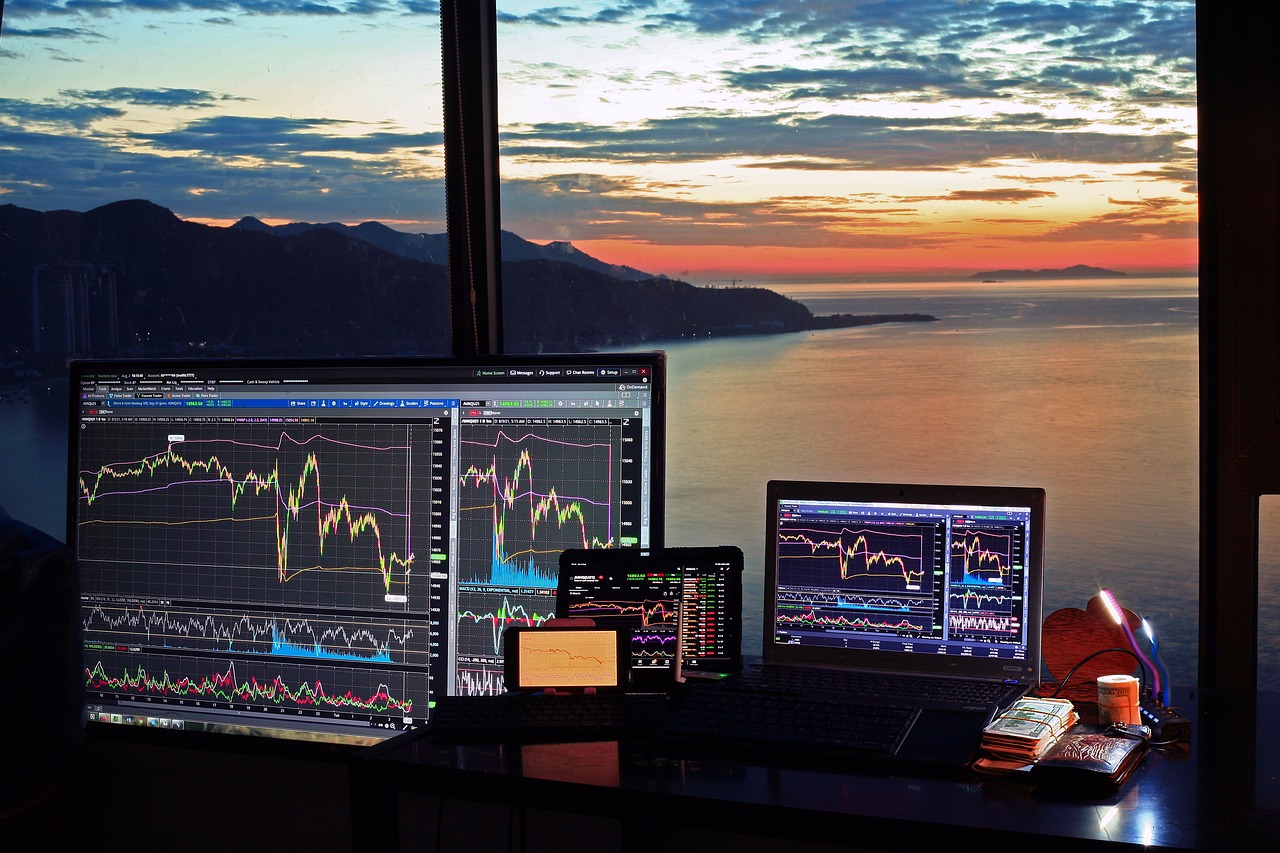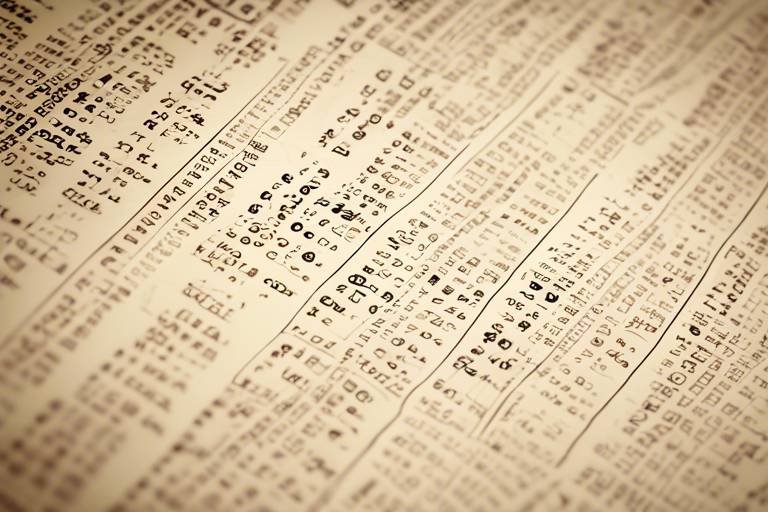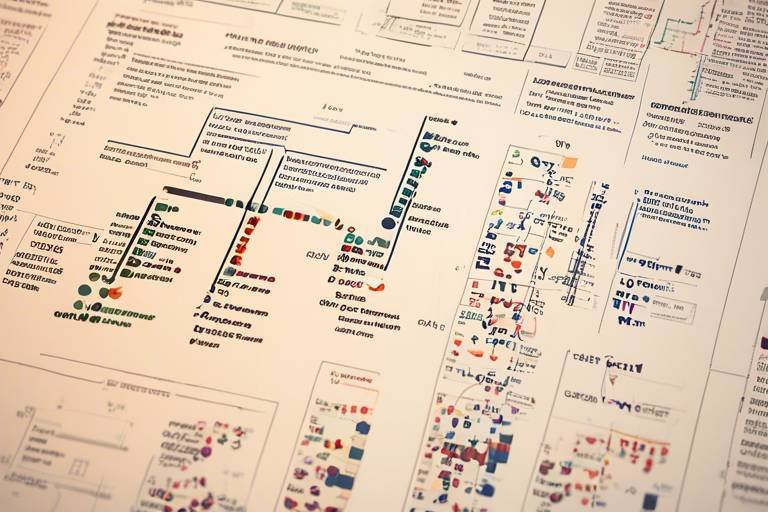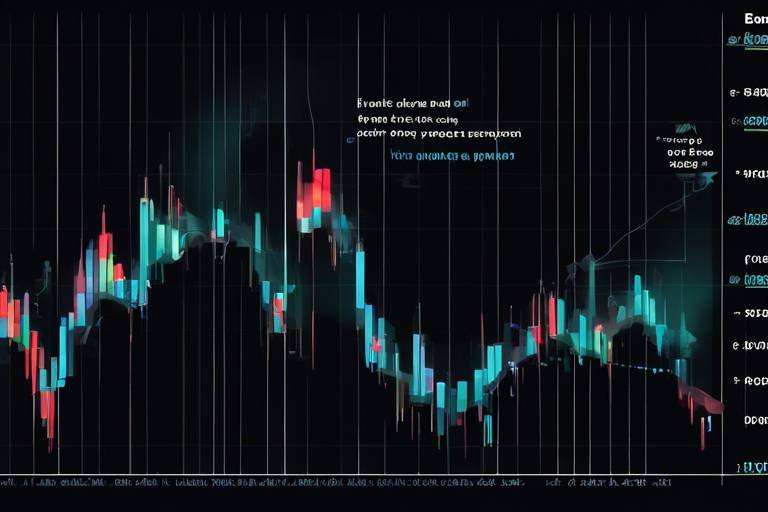How to Use the Parabolic SAR for Trading Decisions
The world of trading can often feel like navigating a vast ocean filled with unpredictable waves and hidden currents. One tool that can serve as a reliable compass for traders is the Parabolic SAR (Stop and Reverse). This powerful indicator not only helps in identifying potential reversals in price movements but also assists in making informed entry and exit decisions. In this article, we’ll dive deep into understanding the Parabolic SAR, how to set it up correctly, interpret its signals, and even combine it with other indicators to enhance your trading strategy.
The Parabolic SAR is a trend-following indicator that provides essential insights into market dynamics. Imagine it as a shadow that trails behind the price, helping traders see where the price might turn. When the price is in an uptrend, the SAR appears below the price; conversely, in a downtrend, it sits above. This unique feature makes the Parabolic SAR valuable for traders looking to identify potential reversals before they happen.
Configuring the Parabolic SAR correctly is akin to tuning a musical instrument; if it’s not set right, the signals can become discordant and misleading. The key settings to focus on include the acceleration factor and the maximum step. These parameters play a pivotal role in how the SAR reacts to price changes and can significantly impact your trading performance.
The acceleration factor is a crucial component of the Parabolic SAR that determines how quickly the indicator reacts to price movements. Think of it as the sensitivity dial on a radio; adjusting it can make a world of difference in clarity. A higher acceleration factor means the SAR will react more swiftly to price changes, which is beneficial in volatile markets, while a lower factor may provide a more stable signal in less volatile conditions.
Selecting the appropriate acceleration factor is like choosing the right gear for your bike; it can make your ride smoother or more challenging. Here are some guidelines to help you find the sweet spot:
- Low Volatility Markets: Consider using an acceleration factor between 0.02 and 0.05.
- Moderate Volatility Markets: A factor between 0.05 and 0.1 might be more suitable.
- High Volatility Markets: Opt for a higher factor, around 0.1 to 0.2, to capture quick price movements.
Even the most seasoned traders can fall prey to common mistakes when setting up the Parabolic SAR. Some pitfalls include:
- Using a one-size-fits-all approach for the acceleration factor.
- Neglecting to adjust settings based on market conditions.
- Failing to backtest the indicator before applying it to live trades.
Avoiding these errors can lead to more accurate trading signals and better decision-making.
Interpreting the signals generated by the Parabolic SAR is essential for effective trading. When the SAR shifts from below to above the price, it signals a potential downtrend, while a shift from above to below indicates a potential uptrend. It's like a traffic light for traders, guiding them on when to go or stop. Incorporating these signals into your trading strategy can significantly enhance your decision-making process.
Using the Parabolic SAR alongside other technical indicators can create a more robust trading strategy. By combining indicators, you can confirm signals and reduce the likelihood of false entries. For instance, pairing the Parabolic SAR with moving averages can provide a clearer picture of the overall trend, while the Relative Strength Index (RSI) can help identify overbought or oversold conditions.
Combining the Parabolic SAR with moving averages can be a game-changer. When the SAR aligns with the direction of a moving average, it reinforces the trend signal. For instance, if the SAR is below the price and the moving average is sloping upwards, it’s a strong indication to consider entering a long position.
The Relative Strength Index (RSI) can complement the Parabolic SAR effectively. By using the RSI to identify overbought or oversold conditions, traders can make more informed decisions. For example, if the Parabolic SAR indicates a potential reversal to a downtrend, but the RSI shows that the market is oversold, it might be wise to wait for further confirmation before making a trade.
Q: What is the best time frame to use the Parabolic SAR?
A: The Parabolic SAR can be used on various time frames, but it’s most effective on daily or weekly charts for long-term trading. For day trading, consider shorter time frames like 15-minute or hourly charts.
Q: Can the Parabolic SAR be used in all market conditions?
A: While the Parabolic SAR is a versatile tool, it performs best in trending markets. In sideways or choppy markets, it may generate false signals.
Q: How do I know when to exit a trade using the Parabolic SAR?
A: A trader should consider exiting a trade when the SAR flips position relative to the price, indicating a potential trend reversal.

Understanding the Parabolic SAR
The Parabolic SAR (Stop and Reverse) is a vital tool in the arsenal of traders, designed to help them identify potential reversals in price trends. Imagine you're on a roller coaster, feeling the exhilarating ups and downs. The Parabolic SAR acts like the safety harness, guiding you through the twists and turns of the financial market. By providing clear signals, it helps traders make informed decisions about when to enter or exit a trade.
At its core, the Parabolic SAR is a trend-following indicator, which means it works best in trending markets. When prices are moving in a specific direction, the Parabolic SAR can help pinpoint potential reversal points. The indicator is visually represented on a price chart as dots placed either above or below the price bars. When the dots are below the price, it indicates an uptrend, while dots above the price suggest a downtrend. This visual cue can be incredibly helpful for traders looking to capitalize on market movements.
But what makes the Parabolic SAR truly unique is its ability to adapt to changing market conditions. It uses a formula that factors in both the current price and the previous SAR value, allowing it to adjust dynamically as prices fluctuate. This means that traders can rely on the Parabolic SAR not just for entry and exit points but also for trailing stops, which can lock in profits as the market moves in their favor.
One of the key aspects of the Parabolic SAR is its acceleration factor, which influences how quickly the indicator responds to price changes. This factor can be adjusted to suit different trading styles and market conditions. For example, a more aggressive trader might opt for a higher acceleration factor, allowing the SAR to react swiftly to price movements, while a more conservative trader might choose a lower factor to avoid false signals.
In summary, the Parabolic SAR is not just a simple indicator; it's a powerful tool that can enhance a trader's ability to navigate the complexities of the market. By understanding how it works and how to interpret its signals, traders can position themselves to make more informed decisions, increasing their chances of success. As we delve deeper into this indicator, we'll explore how to set it up correctly, interpret its signals, and combine it with other indicators for a comprehensive trading strategy.
- What does the Parabolic SAR indicate? The Parabolic SAR indicates potential price reversals and helps traders identify trends.
- How is the Parabolic SAR calculated? It is calculated using the previous SAR value, the highest price in an uptrend, and the acceleration factor.
- Can the Parabolic SAR be used in all market conditions? While it is most effective in trending markets, it can produce false signals in sideways or choppy markets.
- What is the best acceleration factor to use? There is no one-size-fits-all answer; it depends on your trading style and the market conditions.

Setting Up the Parabolic SAR
When it comes to trading, having the right tools at your disposal can make all the difference, and the Parabolic SAR is no exception. Setting it up correctly is crucial for receiving accurate signals that can guide your trading decisions. The Parabolic SAR is designed to provide traders with a visual representation of potential price reversals, but how you configure it can significantly affect its performance. One of the first things to consider is the acceleration factor, which determines how quickly the indicator reacts to price changes. A well-set acceleration factor can mean the difference between catching a trend early and missing out entirely.
To set up the Parabolic SAR effectively, you should consider a few key parameters:
- Acceleration Factor (AF): This typically starts at 0.02 and can be adjusted up to 0.2. A higher AF means the Parabolic SAR will react more quickly to price movements.
- Maximum Step: This is the maximum value the acceleration factor can reach. It ensures that the SAR doesn’t become overly sensitive in volatile markets.
Let's dive deeper into the specifics of these settings. The acceleration factor is critical because it dictates how aggressively the Parabolic SAR will track the price. If you set it too low, you might miss out on significant moves; if it's too high, you could get false signals that lead to premature trades. It’s like trying to find the perfect balance in a seesaw; too much weight on one side, and it tips over.
Moreover, understanding the maximum step is equally important. This setting acts as a safety net, preventing the SAR from becoming overly reactive during sudden price spikes. For instance, if the market experiences a lot of volatility, a high maximum step can help maintain the integrity of your signals, ensuring that you don’t make hasty decisions based on short-lived price movements.
However, even seasoned traders can make mistakes when configuring the Parabolic SAR. Common pitfalls include:
- Setting an acceleration factor that is too high, which can lead to frequent and unnecessary trades.
- Ignoring market conditions; what works in a trending market may not be suitable in a ranging market.
- Failing to backtest the settings before applying them in live trading scenarios.
To avoid these mistakes, it’s essential to take the time to understand your trading environment and adjust the Parabolic SAR settings accordingly. Experiment with different values in a demo account to see how they perform under various market conditions. Remember, the goal is to create a setup that aligns with your trading strategy, whether it’s day trading, swing trading, or long-term investing.
In summary, setting up the Parabolic SAR is not just about plugging in numbers; it’s about understanding how those numbers interact with market dynamics. By carefully adjusting the acceleration factor and maximum step, and by avoiding common configuration mistakes, you can harness the full potential of the Parabolic SAR to make informed trading decisions.

Acceleration Factor Explained
The acceleration factor is a pivotal component of the Parabolic SAR (Stop and Reverse) indicator, acting as a speedometer for how quickly the indicator reacts to price changes. In simpler terms, think of it as the throttle of a car; the more you push it, the faster you go. When the acceleration factor is set higher, the Parabolic SAR will adjust more rapidly to price movements, potentially providing earlier signals for traders. However, this speed comes with a trade-off—higher sensitivity can lead to more false signals, especially in choppy or sideways markets.
Understanding how the acceleration factor operates is crucial for any trader looking to leverage the Parabolic SAR effectively. The default value is typically set at 0.02, but it can be adjusted between 0.01 and 0.3 depending on the trader's strategy and the market conditions. For instance, in a trending market, a higher acceleration factor may help capture profits earlier, while a lower factor may be more suitable in a volatile environment where price swings are common.
To illustrate this concept, consider the following table that outlines how different acceleration factors can impact trading signals:
| Acceleration Factor | Market Condition | Effect on Signals |
|---|---|---|
| 0.01 | Choppy/Sideways | Fewer false signals, slower reaction |
| 0.02 | Moderate Trend | Balanced sensitivity, ideal for most traders |
| 0.03 | Strong Trend | Quicker signals, higher risk of false breaks |
As you can see, choosing the right acceleration factor is not just about speed; it’s about finding a balance that fits your trading style and the current market conditions. If you’re too aggressive with a high acceleration factor, you might find yourself getting whipsawed by the market, which can be frustrating and costly. On the flip side, being too conservative might lead you to miss out on profitable trades. Therefore, it’s essential to experiment with different settings in a demo account before committing real funds.
In summary, the acceleration factor is a critical element of the Parabolic SAR that influences how quickly the indicator responds to price changes. By understanding its implications and adjusting it according to market conditions, traders can enhance their decision-making process and improve their overall trading performance.

Choosing the Right Acceleration Factor
Choosing the right acceleration factor for the Parabolic SAR is crucial to ensure that your trading strategy is both effective and reliable. The acceleration factor essentially determines how aggressively the indicator reacts to price changes. A higher acceleration factor means that the SAR will move closer to the price, which can provide earlier signals but may also lead to more false alarms. Conversely, a lower acceleration factor results in a more gradual approach, which can help filter out noise but may cause you to miss out on some opportunities.
When selecting the right acceleration factor, consider the following:
- Market Conditions: Different market conditions require different settings. For instance, in a trending market, a higher acceleration factor might work better to capture quick price movements. However, in a choppy or sideways market, a lower factor may reduce the number of false signals.
- Volatility: In highly volatile markets, a lower acceleration factor can help avoid getting whipsawed by rapid price movements. On the other hand, in a stable market, a higher factor can maximize potential gains.
- Personal Trading Style: Your individual trading style plays a significant role in determining the best acceleration factor. If you prefer quick trades, a higher factor may suit you, whereas more conservative traders might lean towards lower values.
It’s important to remember that there is no one-size-fits-all answer when it comes to choosing the right acceleration factor. A good starting point is to use the default value of 0.02, which is commonly used among traders. From there, you can experiment by adjusting the factor in small increments, observing how it affects your trading signals and overall performance.
Additionally, backtesting your strategy with different acceleration settings can provide valuable insights. By analyzing historical data, you can identify which settings yield the best results under various market conditions. Keep in mind that the effectiveness of the acceleration factor can also vary based on the asset you are trading, so what works for one market may not necessarily apply to another.
In conclusion, the key to effectively using the Parabolic SAR lies in understanding how the acceleration factor influences your trading decisions. By carefully considering market conditions, volatility, and your personal trading style, you can make informed choices that enhance your trading performance.
Q1: What is the typical range for the acceleration factor?
A1: The typical range for the acceleration factor is between 0.01 and 0.3. Most traders start with a default of 0.02 and adjust based on their specific trading needs.
Q2: Can I use the Parabolic SAR in all types of markets?
A2: While the Parabolic SAR can be used in various markets, it is most effective in trending markets. In sideways or choppy markets, it may generate false signals.
Q3: How often should I adjust my acceleration factor?
A3: Adjust your acceleration factor based on changing market conditions. It’s advisable to review your settings regularly, especially during significant market shifts.

Common Mistakes in Configuration
When it comes to configuring the Parabolic SAR, many traders stumble into common pitfalls that can significantly impact their trading performance. One of the most prevalent mistakes is neglecting to adjust the settings according to market conditions. For instance, using a default acceleration factor without considering the volatility of the asset can lead to misleading signals. In a highly volatile market, a standard setting may result in frequent whipsaws—false signals that can drain your trading account faster than you can say "stop loss."
Another frequent error is over-reliance on the Parabolic SAR alone without considering other factors such as market trends, news events, or even the broader economic environment. Think of the Parabolic SAR as a compass; it can guide you, but it shouldn't be your only tool for navigation. Ignoring other indicators can lead to a skewed perspective on market movements, resulting in poor trading decisions.
Moreover, many traders fail to recognize the importance of backtesting their settings. Failing to backtest can be akin to sailing a ship without checking the weather forecast. You might find yourself caught in a storm when you least expect it. By backtesting your configuration on historical data, you can better understand how the Parabolic SAR would have performed in different market conditions, allowing you to fine-tune your settings for optimal performance.
Additionally, inconsistent monitoring of the Parabolic SAR can lead to missed opportunities or unnecessary losses. Traders often set their configurations and then forget about them, failing to adapt to changing market dynamics. It's essential to regularly revisit your settings and adjust them as necessary, much like a gardener tending to their plants to ensure they thrive.
Lastly, one of the most critical mistakes is not having a solid risk management strategy in place. Even the best configurations can lead to losses if you don't manage your risk effectively. It's crucial to set stop-loss orders and determine your position sizes based on your overall trading plan. Remember, the goal is not just to make profits but to protect your capital.
In summary, avoiding these common mistakes in configuring the Parabolic SAR can significantly improve your trading outcomes. By paying attention to market conditions, incorporating other indicators, backtesting your settings, consistently monitoring your configurations, and maintaining a solid risk management strategy, you can harness the full potential of the Parabolic SAR in your trading arsenal.
- What is the Parabolic SAR?
The Parabolic SAR (Stop and Reverse) is a trend-following indicator used to identify potential reversals in price movement. It helps traders decide when to enter or exit trades.
- How do I set the acceleration factor?
The acceleration factor determines how quickly the SAR moves in relation to price changes. It's typically set between 0.01 to 0.2, but you should adjust it based on market volatility.
- Can I use the Parabolic SAR with other indicators?
Yes! Combining the Parabolic SAR with other indicators, such as moving averages or the RSI, can enhance your trading decisions and provide better market insights.
- What are the common mistakes to avoid when using the Parabolic SAR?
Common mistakes include neglecting to adjust settings for market conditions, over-relying on the indicator, failing to backtest configurations, inconsistent monitoring, and not having a risk management strategy.

Interpreting Parabolic SAR Signals
The Parabolic SAR, or Stop and Reverse, is a powerful tool in a trader's arsenal, providing clear signals that can guide your decisions in the fast-paced world of trading. But how do you interpret these signals effectively? Understanding the signals generated by the Parabolic SAR is crucial for making informed trading decisions. Essentially, the indicator provides dots that are placed either above or below the price chart, which can signal potential reversals in the market trend.
When the SAR dots are located below the price, it indicates a bullish trend, suggesting that traders might consider entering long positions. Conversely, when the dots appear above the price, it signals a bearish trend, indicating that it may be time to exit long positions or even consider shorting the asset. The key here is to recognize these dots as visual cues that represent the market's momentum. It's like having a compass in the wilderness; it helps you navigate through the dense forest of market movements.
However, interpreting these signals is not just about looking at the dots in isolation. It’s essential to consider the context of the market. For instance, during strong trends, the Parabolic SAR may generate signals that could be misleading, leading traders to exit positions prematurely. It’s important to combine these signals with other forms of analysis. For example, if the SAR indicates a potential reversal but other indicators, such as volume or market sentiment, suggest that the trend is still strong, it might be wise to hold your position a little longer.
One common mistake traders make is relying solely on the Parabolic SAR signals without considering other factors. While the SAR can provide valuable insights, it should be part of a broader trading strategy. To enhance your interpretation of the Parabolic SAR signals, consider the following:
- Market Conditions: Always assess whether the market is trending or ranging. The Parabolic SAR works best in trending markets.
- Timeframe: Different timeframes can yield different signals. Ensure you are looking at the appropriate timeframe for your trading strategy.
- Confirmation: Use additional indicators to confirm the signals generated by the Parabolic SAR. This might include moving averages or momentum indicators.
In summary, interpreting Parabolic SAR signals requires a blend of understanding the indicator itself and the broader market context. By keeping an eye on the placement of the dots and integrating additional analysis, traders can significantly improve their decision-making process. Remember, trading is not just about following signals blindly; it’s about understanding the story behind the numbers and making informed choices that align with your trading goals.
What does it mean when the Parabolic SAR is above the price?
When the Parabolic SAR is above the price, it indicates a bearish trend. Traders may consider this a signal to exit long positions or to enter short positions.
Can the Parabolic SAR be used in ranging markets?
While the Parabolic SAR can be used in ranging markets, it’s more effective in trending markets. In ranging conditions, the signals may produce false positives, leading to potential losses.
How often should I check the Parabolic SAR signals?
The frequency of checking the Parabolic SAR signals depends on your trading strategy and the timeframe you are using. Day traders may check it multiple times a day, while swing traders might look at it daily or weekly.

Combining Parabolic SAR with Other Indicators
The world of trading is like a complex puzzle, and when you’re trying to piece together the best strategy, using the right tools is essential. One such tool is the Parabolic SAR, which is fantastic for identifying potential reversals in price movement. However, just like a chef wouldn’t rely solely on one spice, traders shouldn’t depend only on the Parabolic SAR. Combining it with other indicators can enhance your trading decisions significantly, providing a more comprehensive view of market dynamics.
When you integrate the Parabolic SAR with other indicators, you’re essentially layering your analysis, which can lead to more informed and confident trading decisions. For example, using it alongside momentum indicators can give you insights into the strength of a trend, while oscillators can help identify overbought or oversold conditions. This multi-faceted approach can help you avoid false signals and improve the accuracy of your trades.
Some effective combinations include:
- Moving Averages: By pairing the Parabolic SAR with moving averages, traders can get a clearer picture of the trend direction. When the Parabolic SAR aligns with the moving average direction, it can serve as a strong confirmation signal.
- Relative Strength Index (RSI): The RSI is a powerful tool that helps traders determine whether an asset is overbought or oversold. When used in conjunction with the Parabolic SAR, it can enhance the timing of entries and exits, allowing traders to capitalize on price corrections effectively.
- Bollinger Bands: These bands help assess market volatility and potential price reversals. When the price touches the outer bands while the Parabolic SAR indicates a reversal, it can signify a strong trading opportunity.
To illustrate how these combinations work, consider the following table that outlines the key indicators and their benefits when paired with the Parabolic SAR:
| Indicator | Benefits |
|---|---|
| Moving Averages | Helps confirm trends and provides entry/exit points. |
| Relative Strength Index (RSI) | Indicates overbought or oversold conditions for better timing. |
| Bollinger Bands | Assesses volatility and potential price reversals. |
When combining these indicators, it’s important to establish a clear trading plan. What works in one market condition may not work in another. By backtesting your strategies with historical data, you can refine your approach and determine which combinations yield the best results for your trading style. Remember, the goal is to create a synergy between indicators that provides clarity and confidence in your trading decisions.
In conclusion, while the Parabolic SAR is a powerful tool on its own, its true potential is unlocked when combined with other indicators. This multi-dimensional analysis not only enhances your understanding of market trends but also equips you with the necessary insights to make informed trading decisions. So, don't hesitate to experiment with different combinations and find a strategy that resonates with your trading philosophy!
1. What is the Parabolic SAR?
The Parabolic SAR (Stop and Reverse) is a trend-following indicator that helps traders identify potential reversals in price movement. It provides signals for entry and exit points based on price action.
2. How do I combine Parabolic SAR with other indicators?
You can combine the Parabolic SAR with other indicators like moving averages, RSI, and Bollinger Bands to create a more robust trading strategy. This allows for better trend confirmation and helps avoid false signals.
3. Can the Parabolic SAR be used in all market conditions?
While the Parabolic SAR is effective in trending markets, it may generate false signals in sideways or choppy markets. It's best used in conjunction with other indicators to validate signals.
4. What is the best way to set up the Parabolic SAR?
The best setup for the Parabolic SAR depends on your trading style and market conditions. Experimenting with different acceleration factors and maximum steps can help you find the most effective settings for your strategy.

Integrating Moving Averages
When it comes to trading, the Parabolic SAR can be a powerful tool on its own, but integrating it with moving averages can take your trading strategy to the next level. Think of it like pairing a fine wine with a gourmet meal; when done right, the combination can enhance the overall experience. Moving averages smooth out price data over a specific period, helping traders identify the direction of the trend more clearly. By overlaying moving averages with the Parabolic SAR, traders can refine their entry and exit points, leading to more informed decisions.
To effectively integrate these two indicators, consider the following approaches:
- Use a Short-Term Moving Average: A short-term moving average, such as the 10-day or 20-day, can provide quick signals that complement the Parabolic SAR. When the price crosses above the moving average, it can signal a potential buy, especially if the Parabolic SAR is also indicating an upward trend.
- Employ a Long-Term Moving Average: A longer moving average, like the 50-day or 200-day, can help identify the overall market trend. If the Parabolic SAR aligns with the long-term moving average, it strengthens the case for a trade. For example, if both indicators suggest a bullish trend, it may be wise to enter a long position.
Moreover, the crossover of moving averages can serve as a confirmation signal for the Parabolic SAR. For instance, when a short-term moving average crosses above a long-term moving average, it’s often seen as a bullish signal. If this crossover coincides with a Parabolic SAR buy signal, traders can feel more confident in their decision.
Here’s a simple table to illustrate how these indicators can work together:
| Indicator | Signal | Action |
|---|---|---|
| Parabolic SAR (Bullish) | Price above the SAR | Consider buying |
| Short-Term MA Crosses Above Long-Term MA | Indicates upward momentum | Confirm buy signal |
| Parabolic SAR (Bearish) | Price below the SAR | Consider selling |
| Short-Term MA Crosses Below Long-Term MA | Indicates downward momentum | Confirm sell signal |
In summary, integrating moving averages with the Parabolic SAR can significantly enhance your trading strategy. By using these indicators in tandem, you can gain a clearer picture of market trends and make more informed decisions. Just remember, like any recipe, the key is in the balance; too much reliance on one indicator can lead to confusion. So, experiment with different settings and combinations until you find the sweet spot that works for you!
Q: What is the best moving average to use with the Parabolic SAR?
A: The best moving average depends on your trading style. Short-term traders might prefer a 10-day or 20-day moving average, while long-term traders may opt for a 50-day or 200-day moving average.
Q: Can I use the Parabolic SAR on any trading platform?
A: Yes, most trading platforms offer the Parabolic SAR as a built-in indicator, allowing you to integrate it with moving averages easily.
Q: How do I know if the signals from the Parabolic SAR and moving averages are reliable?
A: It's essential to backtest your strategy and use additional confirmation methods, such as volume analysis or other indicators, to enhance reliability.

Utilizing RSI with Parabolic SAR
The Relative Strength Index (RSI) and the Parabolic SAR are two powerful tools in a trader's arsenal, and when used together, they can significantly enhance trading decisions. The RSI is a momentum oscillator that measures the speed and change of price movements, providing insights into whether a market is overbought or oversold. On the other hand, the Parabolic SAR helps identify potential reversals in price trends. By integrating these two indicators, traders can create a more robust trading strategy that not only signals potential entry and exit points but also confirms the strength of the trend.
When using the RSI in conjunction with the Parabolic SAR, traders can look for specific scenarios where the signals from both indicators align. For example, if the Parabolic SAR indicates a potential upward trend while the RSI shows a value below 30 (indicating oversold conditions), this could be a strong signal to consider entering a long position. Conversely, if the Parabolic SAR suggests a downward trend and the RSI is above 70 (indicating overbought conditions), it may be wise to look for an opportunity to exit a long position or even enter a short position.
To illustrate the effectiveness of this combination, consider the following table that outlines potential trading scenarios:
| Scenario | Parabolic SAR Signal | RSI Condition | Action |
|---|---|---|---|
| 1 | Flipping to below price | RSI < 30 | Consider Long Position |
| 2 | Flipping to above price | RSI > 70 | Consider Short Position |
| 3 | Continues below price | RSI 30-70 | Hold Position |
| 4 | Continues above price | RSI 30-70 | Hold Position |
It's essential to remember that while both indicators can provide valuable insights, they should not be used in isolation. Market conditions can change rapidly, and relying solely on one indicator may lead to premature decisions. Therefore, always consider other factors such as market news, economic indicators, and overall market sentiment when making trading decisions.
In summary, utilizing the RSI alongside the Parabolic SAR can significantly enhance your trading strategy. By confirming signals from both indicators, traders can make more informed decisions, ultimately leading to better trading outcomes. As with any trading strategy, practice and experience will help refine your approach and improve your ability to interpret these signals effectively.
- What is the best time frame for using the Parabolic SAR and RSI together?
The effectiveness of these indicators can vary by market and trading style. Many traders find success using them on daily or hourly charts, but it's essential to experiment and find what works best for you.
- Can I use other indicators with the Parabolic SAR and RSI?
Absolutely! Many traders combine these indicators with moving averages, MACD, or Bollinger Bands for a more comprehensive analysis.
- How do I adjust the settings for the Parabolic SAR?
Commonly, traders start with a default acceleration factor of 0.02 and a maximum step of 0.2. However, adjusting these settings based on market volatility can yield better results.
Frequently Asked Questions
- What is the Parabolic SAR and how does it work?
The Parabolic SAR, or Stop and Reverse, is a trend-following indicator that helps traders identify potential reversals in price movement. It provides essential signals for making entry and exit decisions based on the direction of the trend. When the price is above the SAR, it indicates an uptrend, and when it is below, it suggests a downtrend.
- How do I set up the Parabolic SAR correctly?
Setting up the Parabolic SAR involves configuring the acceleration factor and maximum step. The acceleration factor determines how quickly the SAR moves in relation to price changes, while the maximum step limits the SAR's distance from the price. It's crucial to adjust these settings based on market conditions to enhance trading performance.
- What is the ideal acceleration factor for the Parabolic SAR?
The ideal acceleration factor can vary depending on market volatility. A common starting point is 0.02, which can be adjusted between 0.01 to 0.3. The key is to find a balance that offers sensitivity to price changes without generating too many false signals.
- What are some common mistakes when using the Parabolic SAR?
Many traders make errors such as using inappropriate settings, ignoring market context, or relying solely on SAR signals without considering other indicators. Avoiding these pitfalls can lead to more accurate trading signals and better decision-making.
- Can I use the Parabolic SAR with other indicators?
Absolutely! Combining the Parabolic SAR with other technical indicators, like moving averages or the Relative Strength Index (RSI), can enhance your trading strategy. This integration helps confirm signals and improves overall market analysis.
- How do moving averages complement the Parabolic SAR?
Using moving averages alongside the Parabolic SAR can create a more robust trading strategy. While the SAR identifies potential reversals, moving averages help confirm the trend direction, allowing traders to make more informed decisions.
- How can I effectively use the RSI with the Parabolic SAR?
The RSI can provide insights into overbought or oversold conditions, which complements the Parabolic SAR's signals. By analyzing both indicators together, traders can identify potential reversals more accurately, enhancing their trading strategies.



















